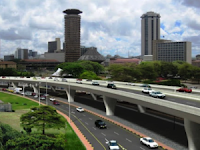Nairobi elevated Road: an eyesore - architect

The Nairobi elevated road:facing intense criticism A MONTH BACK, we ran an article questioning the viability of the elevated road over Nairobi's uhuru Highway. http://eaers.blogspot.com/2012/10/is-nairobis-double-decker-road.html We have come across an article providing compelling aesthestic reasons for discarding the project. The article proposes that the funds be used to expand the Southern by-pass to 8 lanes. The article initially written as a letter to the PS ministry of Roads and public works, first appeared on a blog on urban planning in Nairobi from where we lifted it. I would like to state my strong disapproval of the planned elevated highway over Uhuru Highway. On the face of it, the elevated highway might look like a very good thing to build. Unfortunately the environmental and social impact assessment study carried out for NUTRIP did not include in the team or consult, architects and town planners. If the study team had included them, they would have t...

.jpg)

